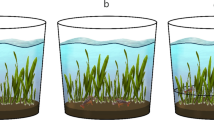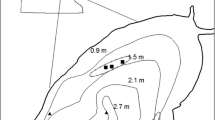Abstract
This study describes the effects of the American red swamp crayfish, Procambarus clarkii Girard, on water quality and sediment characteristics in the Spanish floodplain wetland, Las Tablas de Daimiel National Park. Our short term enclosure study during a summer drawdown revealed that crayfish acted as a nutrient pump that transformed and translocated sediment bound nutrients to the water column. Water quality impoverishment was mainly due to the increase of dissolved inorganic nutrients (soluble reactive phosphorus and ammonia), and a significant increase of total suspended solids occurred likely as a result of crayfish associated bioturbation. At the same time, crayfish reduced the content of organic matter in the sediment and we observed a slight increase of total sediment phosphorus and nitrogen content as a result of crayfish benthic activity. P. clarkii effects, in terms of internal nutrient loading (229.91 mg TP m−2 d−1), were shown to be important on a local scale, indicating the significance of internal nutrient supply to water column primary producers particularly under low external supply (summer). Extrapolations to the whole ecosystem, however, revealed a negligible crayfish contribution (0.06%) to total internal nutrient loading (0.035 mg TP m−2 d−1). Hence, crayfish spatial heterogeneity patterns are important in global and local matter fluxes and nutrient cycles in wetlands.
Similar content being viewed by others
References>
Andersson, G., H. Berggren, G. Cronberg & C. Gelin, 1978. Effects of planktivorous and benthivorous fish on organisms and water chemistry in eutrophic lakes. Hydrobiologia 59: 9–15.
Andersson, G., W. Graneli & J. Stenson, 1988. The influence of animals on phosphorus cycling in lake ecosystems. Hydrobiologia 170: 267–284.
Angeler, D. G., 2000. Wetlands in Mediterranean Europe: Threats and possible Solutions. European Community, Training and Mobility of Researchers Report No. ERBFMBICT983001, Brussels, Belgium.
Angeler, D. G., M. Alvarez–Cobelas, C. Rojo & S. Sánchez– Carrillo, 2000a. The significance of water inputs to plankton biomass and trophic relationships in a semi-arid freshwater wetland (central Spain). J. Plankton Res. 22: 2075–2093.
Angeler, D. G., M. Alvarez-Cobelas, M. A. Rodrigo & S. Sánchez– Carrillo, 2000b. Wetlands in semi-arid Europe: how to cope with eutrophication. Abstract of the 21st Conference of the Society of Wetland Scientists – Wetland Millennium Event, Quebec City, Canada: 178 pp.
Angeler, D. G., M. Alvarez-Cobelas, S. Sánchez-Carrillo & M.A. Rodrigo, in press. Assessment of exotic fish impacts on water quality and zooplankton in a semi-arid floodplain wetland. Aquat. Sci.
APHA, 1989. Standard Methods for the Examination of Water and Wastewater. 17th edn. Washington, D.C.
Avault, J. W. 1992. A review of world crustacean aquaculture II. Aquacult. Mag. 18: 83–92.
Bachman, R. W. & D. E. Canfield, 1996. Use of an alternative method for monitoring total nitrogen concentrations in Florida lakes. Hydrobiologia 323: 1–8.
Bernardo, J. M. & M. Ilhéu, 1994. Red swamp crayfish (Procambarus clarkii): Contribution to material cycling. Verh. int. Ver. Limnol. 25: 2447–2449.
Brabrand, A., B. A. Faafeng & J. P. M. Nilssen, 1990. Relative importance of phosphorus supply to phytoplankton production: fish excretion versus external loading. Can. J. Fish. aquat. Sci. 47: 364–372.
Breukelaar, A. W., E. H. R. R. Lammens, J. G. P. Klein–Breteler & I. Tátrai, 1994. Effects of benthivorous bream (Abramis brama) and carp (Cyprinus carpio) on sediment resuspension and concentrations of nutrients and chlorophyll a. Freshwat. Biol. 32: 113–121.
Carpenter, S. R., J. F. Kitchell & J. R. Hodgson, 1985. Cascading trophic interactions and lake productivity. Bioscience 35: 634–639.
Chambers, P. A., J. M. Hanson, J. M. Burke & E. E. Prepas, 1990. The impact of Orconectes virilis on aquatic macrophytes. Freshwat. Biol. 24: 81–91.
Dahl, O., 1991. Release of phosphorus and nitrogen from pelagic populations of roach (Rutilus rutilus) and bleak (Alburnus alburnus): Unpublished Thesis, University of Oslo.
Den Oude, P. J. & R. D. Gulati, 1988. Phosphorus and nitrogen excretion rates of zooplankton from eutrophic Loosdrecht lakes, with notes on other P sources for phytoplankton requirements. Hydrobiologia 169: 379–390.
Ejsmont–Karabin, J., 1984. Phosphorus and nitrogen excretion by lake zooplankton (rotifers and crustaceans) in relation to individual body weight of the animals, ambient temperature and presence and absence of food. Ekol. Polska, Ser. A 32: 3–42.
Feminella, J. W. & V. H. Resh, 1989. Submersed macrophytes and grazing crayfish: an experimental study of herbivory in a Californian freshwater marsh. Holarctic Ecol. 12: 1–8.
Flint, R. W. & C. R. Goldman, 1975. The effects of a benthic grazer on the primary productivity of the lake littoral zone of lake Tahoe. Limnol. Oceanogr. 20: 935–944.
Fukuhara, H. & K. Yasuda, 1987. Enhancement of inorganic nitrogen and phosphate release from lake sediment by tubificid worms and chironomid larvae. Oikos 48: 312–320.
Fukuhara, H. & K. Yasuda, 1989. Ammonium excretion by some freshwater zoobenthos from a eutrophic lake. Hydrobiologia 173: 1–8.
Gardner, W. S., T. F. Nepla, M. A. Quigley & J. M. Malczyk, 1981. Release of phosphorus by certain benthic invertebrates. Can. J. Fish. aquat. Sci. 38: 978–981.
Gardner, W. S., T. F. Nepla, D. S. Slavenus & G. A. Lairds, 1983. Patterns and rates of nitrogen release by benthic Chironomidae and Oligochaeta. Can. J. Fish. aquat. Sci. 40: 259–266.
Graneli, W., 1979. The influence of Chironomus plumosus larvae on the oxygen uptake of sediment. Arch. Hydrobiol. 87: 385–403.
Gutiérrez–Yurrita, P. J., G. Sancho, M. A. Bravo, A. Baltanás & C. Montes, 1998. Natural diet of the red swamp crayfish Procambarus clarkii in the Doñana National Park freshwater marsh (SW Spain). J. Crust. Biol. 8: 120–127.
Gutiérrez–Yurrita, P. J. & C. Montes, 1999. Bioenergetics and phenology of reproduction of the introduced red swamp cray-fish, Procambarus clarkii, in Doñana National Park, Spain, and implications for species management. Freshwat. Biol. 42: 561–574.
Hansson, L.-A., L. Johansson & L. Persson, 1987. Effects of fish grazing on nutrient release and succession of primary producers. Limnol. Oceanogr. 32: 723–729.
Hessen, D. O., G. Kristiansen & J. Skurdal, 1993. Nutrient release from crayfish and its potential impact on primary production in lakes. Freshwat. Crayfish 9: 311–317.
Hobbs, H. H., J. P. Jass & J. V. Huner, 1989. A review of global crayfish introductions with particular emphasis on two north American species (Decapoda, Cambaridae). Crustaceana 56: 299–316.
Horppila, J. & T. Kairesalo, 1992. Impact of bleak (Alburnus alburnus) and roach (Rutilus rutilus) on water quality, sedimentation and internal nutrient loading. Hydrobiologia 243/244: 323–331.
Kitchell, J. F., J. F. Koonze & P. S. Tennis, 1975. Phosphorus flux through fishes. Verh. int. Ver. Limnol. 19: 2478–2484.
Kristiansen, G. & D. O. Hessen, 1992. Nitrogen and phosphorus excretion from the noble crayfish, Astacus astacus L., in relation to food type and temperature. Aquaculture b102: 245–264.
Lamarra, V. A., 1975. Digestive activities of carp as a major contributor to the nutrient loading of lakes. Verh. int. Verein. Limol. 19: 2461–2468.
Lehman, J. T., 1980. Release and cycling of nutrients between planktonic algae and herbivores. Limnol. Oceanogr. 25: 620–632.
Lodge, D. M. & A. M. Hill, 1994. Factors governing species composition, population size and productivity of cool-water crayfishes. Nord. J. Freshwat. Res. 69: 111–136.
Lodge, D. M. & J. G. Lorman, 1987. Reductions in submersed macrophyte biomass and species richness by the crayfish Orconectes rusticus. Can. J. Fish. aquat. Sci 44: 5091–597.
Lodge, D. M., M. W. Kershner, J. E. Aloi & A. P. Covich, 1994. Effects of an omnivorous crayfish (Orconectes rusticus) on a freshwater littoral food web. Ecology 75: 1265–1281.
Lougheed, V. L., B. Crosbie & P. Chow–Fraser, 1998. Predictions on the effect of common carp (Cyprinus carpio) exclusion on water quality, zooplankton, and submergent macrophytes in a Great Lakes wetland. Can. J. Fish. aquat. Sci. 55: 1189–1197.
Marker, A. F. H., E. A. Nusch, H. Rai & B. Rieman, 1980. The measurement of photosynthetic pigments in freshwater and standardisation of methods: conclusions and recommendations. Arch. Hydrobiol./Ergeb. Limnol. 14: 91–106.
Matthews, M. & J. D. Reynolds, 1992. Ecological impact of crayfish plague in Ireland. Hydrobiologia 234: 1–6.
Matveev, V., L. Matveeva & G. J. Jones, 2000. Relative impacts of Daphnia grazing and direct stimulation by fish on phytoplankton abundance in mesocosm experiments. Freshwat. Biol.44: 375–385.
McCormick, P., 1990. Direct and indirect effects of consumers on benthic algae in isolated pools of an ephemeral stream. Can. J. Fish. aquat. Sci. 47: 2057–2065.
Meijer, M.-L., M. W. De Haan, A. W. Breukelaar & H. Buitfeld, 1990. Is the reduction of the benthivorous fish an important cause of light transparency following biomanipulation in shallow lakes? Hydrobiologia 200/201: 303–315.
Momot, W. T., 1995. Redefining the role of crayfish in aquatic ecosystems. Rev. Fish. Sci. 3: 33–63.
Montes, C., M. A. Bravo, A. Baltanás, P. J. Gutiérrez & C. M. Duarte, 1993. Ecological baselines for an integral management of the American red swamp crayfish (Procambarus clarkii) in the Doñana National Park. ICONA, Madrid [in Spanish].
Nakashima, B. S. & W. C. Leggett, 1980. The role of fishes in the regulation of phosphorus availability in lakes. Can. J. Fish. aquat. Sci. 37: 1540–1549.
Nalepa, T. F., W. S. Gardner & J. M. Makzyk, 1983. Phosphorus release from three kinds of benthic invertebrates: effects on substrate and water medium. Can. J. Fish. aquat. Sci. 40: 810–813.
Nyström, P., C. Brönmark & W. Granéli, 1996. Patterns in benthic food webs: a role of omnivorous crayfish. Freshwat. Biol. 36: 631–646.
Penn, G. H., Jr., 1943. A study of the life history of the Louisiana red-crawfish, Cambarus clarkii Girard. Ecology 24: 1–18.
Peters, R. H., 1975. Phosphorus regeneration by natural populations of limnetic zooplankton. Verh. Int. Ver. Limnol. 19: 273–279.
Peters, R. H. & F. H. Rigler, 1973. Phosphorus release by Daphnia. Limnol. Oceanogr. 18: 821–839.
Revsbech, N. P., J. Sörensen, T. H. Blackburn & J. P. Lomholt, 1980. Distribution of oxygen in marine sediments measured with microelectrodes. Limnol. Oceanogr. 25: 403–411.
Sánchez-Carrillo, S. & M. Alvarez–Cobelas, 2001. Nutrient dynamics and eutrophication patterns in a semi-arid wetland: effects of fluctuating hydrology. Wat. Air Soil Pollut. 131: 97–118.
Sommer, T. R. & C. R. Goldman, 1983. The crayfish Procambarus clarkii from California ricefields: ecology, problems and potential harvest. Freshwat. Crayfish 5: 418–428.
Søndergaard M., P. Kristensen & E. Jeppesen, 1992. Phosphorus release from resuspended sediment in the shallow and windexposed Lake Arresø, Denmark. Hydrobiologia 228: 91–99.
SSSA (Soil Science Society of America), 1971. In Walsh, L. M. (ed.), Instrumental Methods for Analysis of Soils and Plant Tissues. Madison, WI: 222 pp.
StatSoft Inc., 1995. STATISTICA for Windows. Tulsa, OK, U.S.A.
Tatrai, I. & V. Istvanovics, 1986. The role of fish in the regulation of nutrient cycling in Lake Balaton, Hungary. Freshwat. Biol. 16: 417–424.
Vanni, M. J. & D. D. Layne, 1997. Nutrient recycling and herbivory as mechanisms in the 'top-down' effect of fish on algae in lakes. Ecology 78: 21–40.
Author information
Authors and Affiliations
Rights and permissions
About this article
Cite this article
Angeler, D.G., Sánchez-Carrillo, S., García, G. et al. The influence of Procambarus clarkii (Cambaridae, Decapoda) on water quality and sediment characteristics in a Spanish floodplain wetland. Hydrobiologia 464, 89–98 (2001). https://doi.org/10.1023/A:1013950129616
Issue Date:
DOI: https://doi.org/10.1023/A:1013950129616




